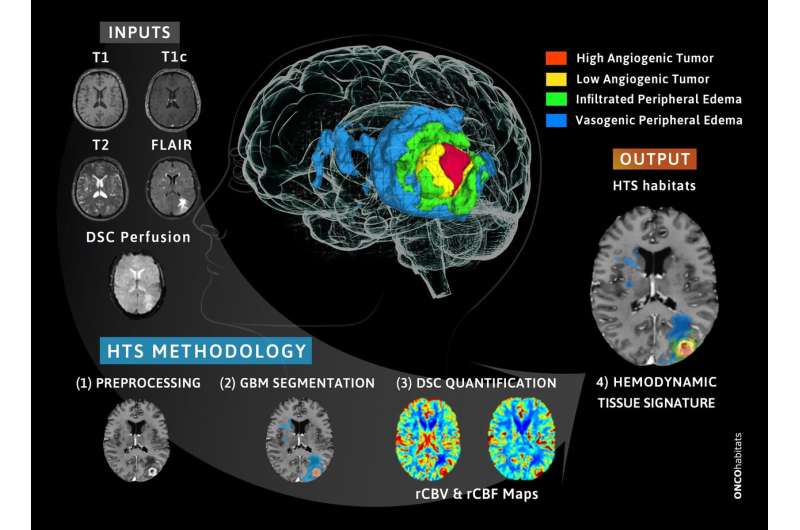ONCOhabitats helps medical doctors know the patients' situation with greater precision. Credit: UPV/Lena Kay
Glioblastoma (GBM) is the most aggressive brain tumor in adults. Currently, it can be treated with neurosurgery, radiotherapy and chemotherapy. Still, the median life expectancy of patients affected with this pathology is no longer than 15 months.
Within this context, researchers at the Universitat Politècnica de València (UPV) have been working for 15 years in new biomedical tools that can help with the follow-up of this tumor. The most recent is ONCOHabitats, a platform that allows medical doctors to know the patient's real situation with greater precision according to the vascularity of different areas of the tumor.
"These results consolidate the effort of almost 15 years working in this field. The potential application of this tool has been validated by seven European hospitals with the first multicenter clinical study promoted by the Universitat Politècnica de València," says Juan Miguel García-Gómez, coordinator of the Biomedical Data Science Lab-ITACA of UPV.
The seven centers that have taken part in the study are the Hospital Universitario de La Ribera, the Hospital de Manises, the Hospital Clínic in Barcelona, the Hospital Universitario Vall d'Hebrón, the Azienda Ospedaliero-Universitaria in Parma (Italy), the Centre Hospitalier Universitaire in Liège (Belgium) and the Oslo University Hospital (Norway). The results have been published in the Journal of Magnetic Resonance Imaging.
Key finding for medical prognosis
The methodology developed by the team of UPV researchers helps to discover new areas in the tumor and makes the monitoring of the patient's progression easier, thanks to new biomarkers. The key lies in the analysis of five types of Magnetic Resonance Images—four morphological MRIs and one perfusion MRI.
According to the researchers at UPV's Biomedical Data Science Lab-ITACA, from these Magnetic Resonance Images and our methodology, it is possible to establish separated areas inside the tumor and the edema. From them, ONCOHabitats allows medical doctors to obtain vascular biomarkers—brain blood volume—in the areas of the active tumor and infiltrated peripheral edema that are directly linked to patients' survival, before they undergo surgery.
Until now, most studies have focused on studying the active tumor. However, we have found a new area of great interest, the infiltrated peripheral edema. We have seen that the biomarkers obtained in this area provide very relevant information on the aggressiveness of the tumor and therefore, on the prognosis and follow-up of the patient.
Within the study, researchers worked with 184 patients' MRIs from the seven centers that took part. The study has proved the robustness of calculating biomarkers using the methodology developed by UPV compared to the variability of applying magnetic resonance image acquisition protocols.
"We have proved in seven hospitals that our methodology is reliable and robust, independently of the variations that can appear when acquiring and processing MRIs and, ultimately, obtaining the biomarkers. These results endorse its viability for the implementation in the clinical practice; the next step is to biologically characterize what is discovered in the image, and we are already working on that," explains María del Mar Álvarez-Torres, researcher at the Biomedical Data Science Lab-ITACA of the Universitat Politècnica de València.
More information: María del Mar Álvarez‐Torres et al, Robust association between vascular habitats and patient prognosis in glioblastoma: An international multicenter study, Journal of Magnetic Resonance Imaging (2019). DOI: 10.1002/jmri.26958
Provided by Universitat Politècnica de València























